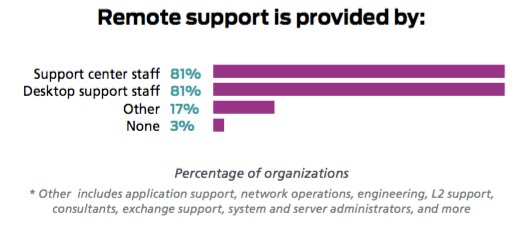Date Published February 15, 2017 - Last Updated December 6, 2017
We are all aware of how rapidly things are changing in the world of technology, and we know that change is accelerating. As technology changes, its application to our work and our lives changes as well. But technology isn’t the only thing that is changing. Of course, the way we support the people who are using technology is changing as well.
The advent of remote control, for example, changed the way desktop support accomplished most of its work. Then someone asked, “If we can fix so many issues remotely, why do we need to escalate to desktop support?” And so the support center staff began to provide remote support. In fact, the HDI 2016 Technical Support Practices & Salary Report tells us that the percentage of organizations in which remote support is provided by the support center staff is identical to the percentage in which it is provided by desktop support staff.

This means that a great deal of desktop support’s work has shifted. Rather than moving around an office or college campus providing in-place fixes, desktop support has taken on a good deal of work from other areas, as discussed in this previous post.
As the work shifts, the metrics—by necessity—must change. Level 1 is taking on more challenging tasks. Desktop support is troubleshooting the network and/or doing port activation, VoIP phone installation, and so on. These activities, while still governed by the support “work orders” we call tickets, are different from what they were.
As the work shifts, the metrics—by necessity—must change.

Yet, as an industry, we are trying to compare ourselves to a former self, via metrics trends. While we can and should look back at the metrics we logged last week, last month, and last year, we need to be mindful that we are not comparing like to like, apples to apples, if you prefer. It’s as if we are comparing oranges to subway trains in some respects, and we need to remember that as we look back to see how far we’ve have come.
Let’s look at a couple of metrics to better understand how things are changing.
- Time to resolve a desktop support issue resolved remotely, as more than half of issues are, is a fraction of what it was before remote support. That changes the staffing requirements, and it certainly has massively positive effects on the productivity of customers/end users who do not have to wait for the technician to show up.
- The number of tickets a technician can resolve in a day has also been affected by virtualization, remote support, and the complexity of the remaining cases where remote support cannot help.
It’s not that we shouldn’t be tracking and trending our metrics over time, it’s that we need to be aware that as the work itself changes, the metrics may be representing different things. As you look back, remember to think about how different the world of support is from what it was even a few years ago.
 Roy Atkinson is HDI's senior writer/analyst, acting as in-house subject matter expert and chief writer for SupportWorld articles and white papers. In addition to being a member of the HDI International Certification Standards Committee and the HDI Desktop Support Advisory Board, Roy is a popular speaker at HDI conferences and is well known to HDI local chapter audiences. His background is in both service desk and desktop support as well as small-business consulting. Roy is highly rated on social media, especially on the topics of IT service management and customer service. He is a cohost of the very popular #custserv (customer service) chat on Twitter, which celebrated its fifth anniversary on December 9, 2014. He holds a master’s certificate in advanced management strategy from Tulane University’s Freeman School of Business, and he is a certified HDI Support Center Manager. Follow him on Twitter @HDI_Analyst and @RoyAtkinson.
Roy Atkinson is HDI's senior writer/analyst, acting as in-house subject matter expert and chief writer for SupportWorld articles and white papers. In addition to being a member of the HDI International Certification Standards Committee and the HDI Desktop Support Advisory Board, Roy is a popular speaker at HDI conferences and is well known to HDI local chapter audiences. His background is in both service desk and desktop support as well as small-business consulting. Roy is highly rated on social media, especially on the topics of IT service management and customer service. He is a cohost of the very popular #custserv (customer service) chat on Twitter, which celebrated its fifth anniversary on December 9, 2014. He holds a master’s certificate in advanced management strategy from Tulane University’s Freeman School of Business, and he is a certified HDI Support Center Manager. Follow him on Twitter @HDI_Analyst and @RoyAtkinson.